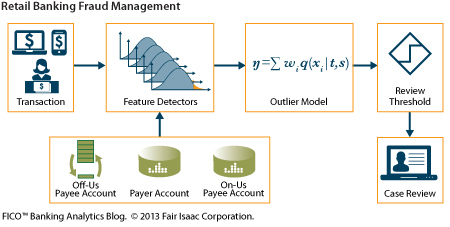Solving the Retail Banking Fraud Challenge
While I frequently blog about analytic innovations in card fraud detection, protecting retail banking accounts is equally important—and equally challenging. Banks worldwide are rec…

While I frequently blog about analytic innovations in card fraud detection, protecting retail banking accounts is equally important—and equally challenging. Banks worldwide are recognizing the need to apply fraud analytics to demand deposit accounts (DDA), including internet banking, mobile banking and other non-card related electronic payment channels. In many regions, the amount of funds transferred through these channels far exceeds those typically seen on payment cards, yet fraud protections are often not as mature.
Protecting retail banking accounts, however, presents an analytics challenge. Given the newness of these electronic payment channels for many banks, there is often a lack of historical and fraud data on which to build the fraud models.
So how do we solve this challenge? By using self-calibrating analytics to understand both sides of the payment, which helps us make a much more accurate decision on whether a transaction is fraudulent.
We recently released custom account-to-account fraud models that monitor electronic payment behaviors for both the payer and payee accounts. This enables the models to capture typical payees, payment amounts and payment behaviors associated with a payer DDA account, while also incorporating recent payment transaction behaviors to the payee account.
Self-calibrating analytics determine outlier behaviors for accounts with abnormal payment activity and generate high scores where the payment is likely fraudulent. As I've blogged previously, this type of model relies less on historical data and can adapt in production on the fly as new fraud patterns emerge. Because of this, self-calibrating analytics are ideal for use in situations where there's insufficient data to build traditional neural network fraud models.
In fact, our last DDA model release was designed to protect a client portfolio that has not yet launched in the market place. We worked closely with the client to design an analytic solution that would provide quality fraud detection for the portfolio from day one. And as new FICO clients sign up for DDA models, we'll have more and more consortium data to build better and better fraud detection solutions in the retail banking space.
Popular Posts

Business and IT Alignment is Critical to Your AI Success
These are the five pillars that can unite business and IT goals and convert artificial intelligence into measurable value — fast
Read more
FICO® Score 10T Decisively Beats VantageScore 4.0 on Predictability
An analysis by FICO data scientists has found that FICO Score 10T significantly outperforms VantageScore 4.0 in mortgage origination predictive power.
Read more
It’s 2021. Do You Know What Your AI Is Doing?
New "State of Responsible AI" report from Corinium and FICO finds that most companies don’t—and are deploying artificial intelligence at significant risk
Read moreTake the next step
Connect with FICO for answers to all your product and solution questions. Interested in becoming a business partner? Contact us to learn more. We look forward to hearing from you.

